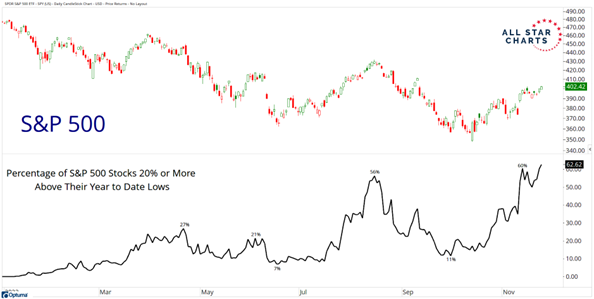Bull Markets are a way to describe the environment. Individual stocks do not enter "bull markets". That's not a thing, explains JC Parets of AllStarCharts.com.
In a bull market, more stocks are going up than going down. In bear markets, you see the exact opposite. We've been consistently talking about how the list of US Sectors in uptrends keeps getting longer, not shorter. And we're seeing an expansion in participation at the individual stock level as well.
It's funny because the media is always pushing this false narrative about 20% being the hurdle to define bull and bear markets. In other words, they'll tell you that when the index is up 20% off its lows, then it's in a bull market. And when it's 20% below its highs, then it's in a bear market.
We've done the work. There's nothing magical about an arbitrary 20%. Fun Fact: The Dow Jones Industrial Average, after rallying over 5000 points since last month is already up 19.3% from its lows.
Is the Dow in a bull market? Turning to S&P 500 (SPX) stocks, notice how 62% of the entire list is already up over 20% from its lows:

Again, stocks do not enter "bull markets". It's just a way to characterize the environment. Are more stocks going up or are more stocks going down? Should we be spending our time looking for stocks to buy? Or should we be spending more time looking for stocks to sell?
Those are the questions we always want to try to answer. And my answer for months now has been to just count. And if you did, you would have noticed that more stocks have been going up for quite some time. Therefore, spending more time looking for stocks to buy has made a lot more sense than spending that time looking for stocks to sell. That decision has rewarded us very nicely. So, I challenge you to just count them.
Forget your "trend-following strategy" that you know doesn't work. Don't worry about whatever stupid "signal" you're waiting for from your expensive computer. Ignore those lagging moving averages that may or may not be crossing over an even more lagging one.
Just count. This doesn't have to be complicated.
To learn more about J.C. Parets, please visit AllStarCharts.com.


















